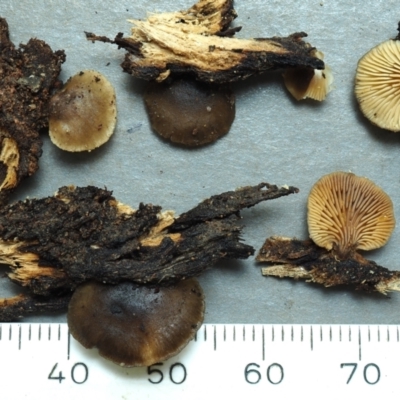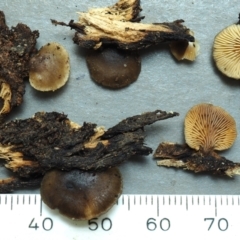Hohenbuehelia
The fruitbody consists of a cap, with gills on the underside. Generally there is no stem, though a very rudimentary one may be present in some species. The caps range from 1 to 10 centimetres in longest dimension and may be fan-shaped, spoon-shaped, kidney-shaped or semi-circular. The caps have a gelatinous layer in the upper part of the cap, giving the cap a jelly-like texture (except in dry conditions). The cap may be smooth or somewhat velvety/hairy and dry or viscid. The caps may be white or (more often) grey, brown or black. The gills are commonly white/creamy to greyish.
Spore print: white.
The genus is cosmopolitan, with the fruitbodies growing from wood (e.g. dead wood, the bark of live trees, woodchip mulch).
Look-alikes
A definite identification of the genus relies on microscopic features. Suppose you have a cap with a jelly-like texture. If it is viscid or if it measures more than say 2 centimetres then Hohenbuehelia is a good guess. Not guaranteed to be correct, but with the odds in its favour.
In our region Resupinatus is probably genus most like Hohenbuehelia, the fruitbodies also containing a gelatinous layer and giving a white spore print. The caps may grow to 2 centimetres and are not viscid. Which means the chance of confusion is greatest if you gave small dry caps.
The caps of Conchomyces bursiformis have a rubbery texture, grow to several centimetres in diameter, are not viscid and give a white spore print. The species was once placed in Hohenbuehelia.
Pleurotus, Lentinellus, Campanella, Crepidotus and Tapinella are other ‘cap-no-stem’ genera. All lack a gelatinous layer. The first three are white spored and species of Lentinellus have gills with raggedy edges and in Campanella you find a few radial gills with varying numbers of cross-connections between them. Crepidotus is a common genus, but with a brown spore print. The gills of Tapinella (yellowish brown spore print) are crimped or wrinkled and are often forked or with cross-connections.
Hohenbuehelia is listed in the following regions:
Canberra & Southern Tablelands | South Coast
Species information
- Hohenbuehelia Scientific name
- Common name
- Not Sensitive
- Unknown
- Unknown
- Up to 1098.62m Recorded at altitude
- Machine learning







